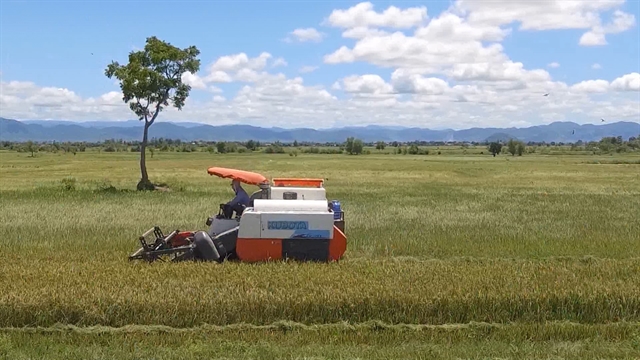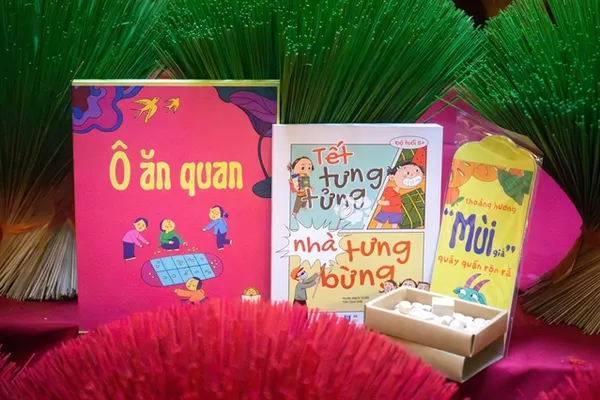 Economy
Economy


|
| Rice harvesting in Central Highlands Gia Lai Province. Nearly 90 million tonnes of by-products are estimated from harvests and processing of crops nationwide. — VNA/VNS Photo |
Deputy Minister of Agriculture and Rural Development Trần Thành Nam talked to the press about the potential of turning agricultural by-products into renewable resources towards the development of circular agricultural economy associated with green growth.
Could you talk about the potential of using by-products in agricultural production?
In the past, the agricultural sector of Việt Nam has made impressive development with market-oriented agricultural production, bringing in improved quality and added value for producers. However, the process of agricultural production has also created a large volume of by-products which would cause environmental protection issues and a waste of an organic resource without proper management measures.
This resource will not only bring in huge economic efficiency but also contribute to environmental protection and reduction of greenhouse gas emission provided it is effectively exploited and used.
The by-products is estimated to amount to nearly 160 million tonnes, including nearly 90 million tonnes from harvests and processing of crops (accounting for 56.2 per cent), 62 million tonnes of cattle and poultry manure, 6 million tonnes from forestry, and nearly one million tonnes from fisheries. The figures demonstrate huge value potential of agricultural by-products.
So if we knew how to exploit and process agricultural by-products, it would bring in high value for the agricultural sector.
How have agricultural by-products been used in agriculture? Have they become renewable resources?
With development policies and orientation of the State, there have been positive changes in the awareness of producers and traders on this issue. Together with the development of science and technology and the market, agricultural by-products have gradually become a real resource and an important production input for many industries. By-products from harvests and processing of crops have been used to produce various kinds of products such as industrial alcohol, organic fertilisers, and biological bed for livestock and forage for cattle or to generate electricity.
However, the use and process of agricultural by-products have yet been effective and comprehensive, failing to create high value products and build a prestigious trademark in the global market.
Besides, annual biomass by-products from main crops such as rice, corn, sugarcane, and vegetables can provide an equivalent amount of 43.4 million tonnes of organic fertilisers, 1.86 million tonnes of urea nitrogen, 1.68 million tonnes of single superphosphate, and 2.23 million tonnes of potassium sulfate. However, these nutrients are almost completely wasted, and there are no incentive mechanisms for reusing them.
In the animal husbandry sector, only 23 per cent of by-products are used to produce organic fertilisers, while the rest goes waste.
This issue requires mechanisms and measures to promote the circular connection between agricultural establishments to effectively use by-products.
There are many models using agricultural by-products as renewable resources. Could you share the values gained from these models?
Many farmers, cooperatives and businesses have developed good models applying the principles of circular economy associated with green growth, using agricultural by-products as renewable resources. For example, some cooperatives and households treat rice straw to produce organic fertilizers.
The market to collect, pack, transport and trade rice straw in the Mekong Delta region has developed rapidly. In the 2021 winter-spring crop, the price of rice straw increased to VNDD55,000-75,000 per 1,000sq.m of fields or equivalent to VNĐ500,000 per hectare of rice straw.
Many businesses produce ethanol from by-products of sugarcane or cassava. The capacity of producing ethanol ranges between 2,100-2,600 litres per hectare of crops, depending on each kind of crop.
In the field of seafood, many companies have processed by-products into high value goods. Vĩnh Hoàn Joint Stock Company, Vietnam Food Joint Stock Company and Sao Mai Joint Stock Company, for example, invested in advanced technology to process seafood by-products into various kinds of products such as fish powder, which is used as animal food; collagen; gelatine; oil; and fish protein hydrolysate. These materials are used both domestically and exported. At present, the industry of processing seafood by-products reached revenue of only $275 million in 2020. However, the figure is expected to increase to $4-5 billion if we can exploit all of the nearly one million tonnes of by-products from the seafood sector.
What are the opportunities and challenges facing the country in developing the circular economy with agricultural by-products being identified as a high value resource?
During the process of agricultural production, we only focus on increasing productivity and output but pay less attention to the excess amount of the production input. The overuse of inorganic fertilizers and plant protection chemical products in farming and the increase of waste from husbandry are threatening the environment.
Some key areas such as the cultivation of rice and other crops, aquaculture and husbandry release millions of tonnes of organic waste, which can be considered as renewable resources for agricultural production and other industries.
Agricultural production is also one of the factors leading to climate change due to greenhouse gas emissions. According to the Ministry of Agriculture and Rural Development, gas emissions from agricultural production account for over 15 per cent of the country's total amount of gas emissions. The Vietnamese Government committed at the COP26 to net zero emission by 2050 and reducing methane emissions to 2030 with the goal of cutting methane emissions by at least 30 per cent from 2020. This is a challenge for the agricultural industry.
The agricultural sector of Việt Nam needs to be based on knowledge and technology to develop circular agriculture in the future, which has become a development trend in many countries.
Việt Nam has joined many global trade agreements and most of these agreements have regulations on sustainable development, environmental protection and climate change adaptation. This will be a premise for Việt Nam to speed up to develop the model of circular agriculture towards green growth.
What are measures that the ministry will take to support and promote the effective use of agricultural by-products?
The ministry has implemented the Prime Minister's Decision to approve the master plan on developing organic agriculture during the 2020-2030 periods with the goals of developing environmental-friendly organic agriculture sustainably with high added value in association with circular economy.
The ministry will organise scientific workshops relating to the circular economy, green growth, ecological farming and agro-economics to raise awareness and change the mindset of farmers, producers and businesses.
The ministry will continue guiding the implementation of models of good agricultural practice, organic agriculture and circular agriculture in association with agricultural tourism development.
Training courses will be organised to develop skilled human resources to meet demand of businesses, cooperatives and farmers in developing organic agriculture and circular agriculture.
The ministry will study to consult and propose the Government mechanisms and policies to encourage the development of the circular economy in agriculture, including solutions to effectively use agricultural by-products and renewable resources. — VNS




